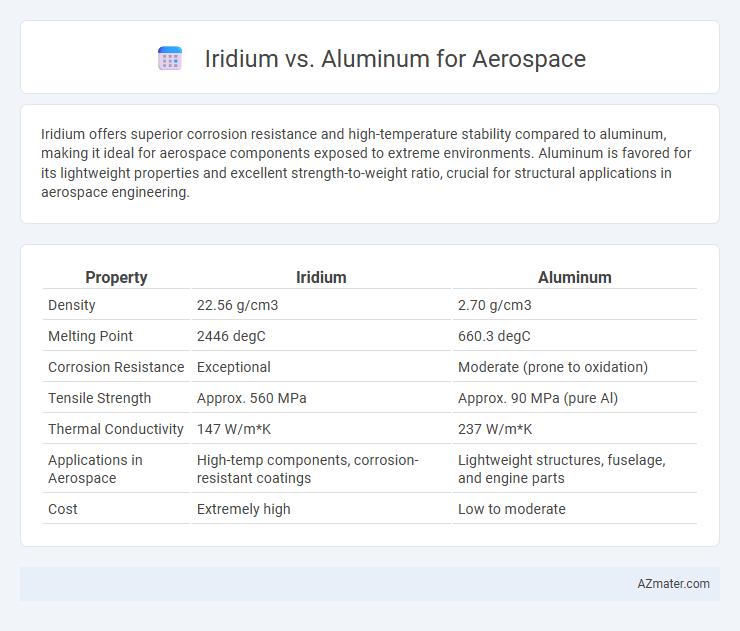Iridium offers superior corrosion resistance and high-temperature stability compared to aluminum, making it ideal for aerospace components exposed to extreme environments. Aluminum is favored for its lightweight properties and excellent strength-to-weight ratio, crucial for structural applications in aerospace engineering.
Table of Comparison
| Property | Iridium | Aluminum |
|---|---|---|
| Density | 22.56 g/cm3 | 2.70 g/cm3 |
| Melting Point | 2446 degC | 660.3 degC |
| Corrosion Resistance | Exceptional | Moderate (prone to oxidation) |
| Tensile Strength | Approx. 560 MPa | Approx. 90 MPa (pure Al) |
| Thermal Conductivity | 147 W/m*K | 237 W/m*K |
| Applications in Aerospace | High-temp components, corrosion-resistant coatings | Lightweight structures, fuselage, and engine parts |
| Cost | Extremely high | Low to moderate |
Introduction: Iridium and Aluminum in Aerospace
Iridium and aluminum are critical materials in aerospace engineering due to their unique properties. Iridium offers exceptional corrosion resistance and high melting point, ideal for extreme environments like rocket engine components and satellite parts. Aluminum provides lightweight strength and excellent corrosion resistance, making it essential for aircraft structures and spacecraft frameworks to enhance fuel efficiency and performance.
Material Properties Overview
Iridium exhibits exceptional corrosion resistance, high melting point (2446degC), and outstanding mechanical strength at elevated temperatures, making it ideal for aerospace components exposed to extreme environments. Aluminum offers a lightweight alternative with good thermal conductivity, excellent strength-to-weight ratio, and ease of fabrication, suitable for structural applications requiring weight reduction. While iridium's density (22.56 g/cm3) limits its use to critical high-temperature parts, aluminum's lower density (2.70 g/cm3) provides significant fuel efficiency advantages in aerospace design.
Strength-to-Weight Ratio Comparison
Iridium exhibits exceptional tensile strength and corrosion resistance but has a high density of 22.56 g/cm3, which negatively impacts its strength-to-weight ratio for aerospace applications. Aluminum alloys, especially those like 7075-T6, offer an excellent strength-to-weight ratio with densities around 2.81 g/cm3 and tensile strengths up to 570 MPa, making them more suitable for lightweight aerospace structures. The significantly lower density of aluminum alloys results in superior strength-to-weight performance crucial for fuel efficiency and payload optimization in aerospace engineering.
Corrosion Resistance: Iridium vs Aluminum
Iridium exhibits exceptional corrosion resistance due to its high density and chemical inertness, making it ideal for harsh aerospace environments involving extreme temperatures and oxidizing conditions. Aluminum, while lightweight and widely used in aerospace, is prone to oxidation and requires protective coatings to prevent corrosion, especially in marine or high-humidity atmospheres. The superior corrosion resistance of iridium ensures longer component lifespan and reduced maintenance in critical aerospace applications where reliability is paramount.
Thermal Stability and Conductivity
Iridium offers exceptional thermal stability with a melting point of 2,466degC, far surpassing aluminum's 660degC, making it ideal for high-temperature aerospace components. Its thermal conductivity is around 147 W/m*K, lower than aluminum's 237 W/m*K, but iridium's performance remains reliable under extreme heat. Aluminum's lightweight nature and high conductivity benefit aerospace applications requiring efficient heat dissipation, while iridium excels in environments demanding superior thermal resistance and durability.
Applications in Aerospace Components
Iridium's exceptional corrosion resistance and high melting point make it ideal for aerospace components exposed to extreme environments, such as rocket engine parts and ignition devices. Aluminum's lightweight nature and excellent machinability are preferred for structural elements like aircraft frames, fuselage, and wing components, where reducing overall weight is critical. Combining iridium for high-temperature, high-stress parts with aluminum in structural applications enhances aerospace performance and material efficiency.
Cost and Resource Availability
Iridium's high cost stems from its rarity and complex extraction process, making it significantly more expensive than aluminum, which is abundant and widely available. Aluminum's lightweight and cost-effectiveness have driven its extensive use in aerospace manufacturing, while iridium is reserved for specialized components requiring exceptional corrosion resistance and high-temperature stability. Resource availability favors aluminum due to its abundant global reserves and well-established supply chains, contrasting with iridium's scarcity limited to a few mining regions.
Manufacturing and Machinability
Iridium exhibits exceptional hardness and high melting points, making its manufacturing process more challenging and requiring specialized machining techniques such as electrical discharge machining (EDM) for aerospace components. Aluminum offers superior machinability with common tooling methods, enabling faster production cycles and cost efficiency in aerospace manufacturing. The choice between iridium and aluminum hinges on balancing iridium's durability and high-temperature performance against aluminum's ease of fabrication and weight advantages.
Environmental Impact and Sustainability
Iridium's environmental impact is significantly higher than aluminum's due to its rarity and energy-intensive extraction process, leading to considerable ecological disruption and high carbon emissions. Aluminum, despite requiring substantial energy for production, is highly recyclable, reducing its overall environmental footprint and enhancing sustainability in aerospace applications. The aerospace industry's shift towards aluminum supports sustainable practices by leveraging its recyclability and lower lifecycle emissions compared to iridium.
Future Trends and Innovations
Iridium's exceptional corrosion resistance and high melting point drive innovations in aerospace propulsion systems and satellite components, enhancing durability in extreme environments. Aluminum's lightweight properties and recyclability support advancements in fuel-efficient airframes and sustainable manufacturing processes, aligning with industry goals for carbon reduction. Emerging material hybrids and nano-engineered coatings combining iridium's strength with aluminum's lightness promise breakthroughs in next-generation aerospace structures.

Infographic: Iridium vs Aluminum for Aerospace
 azmater.com
azmater.com